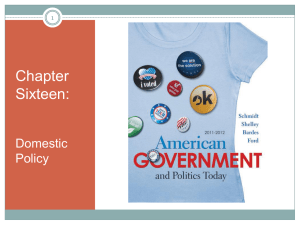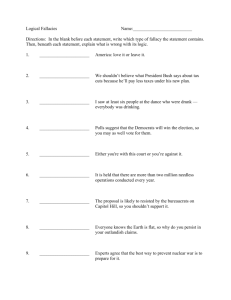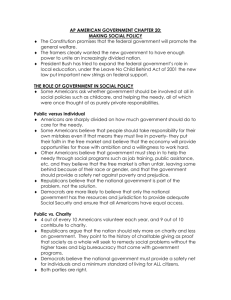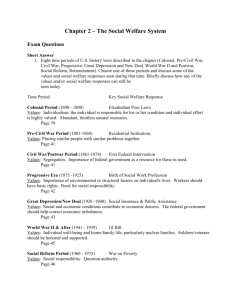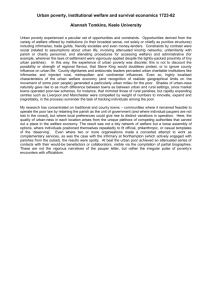Domestic Policy - Kenston Local Schools
advertisement
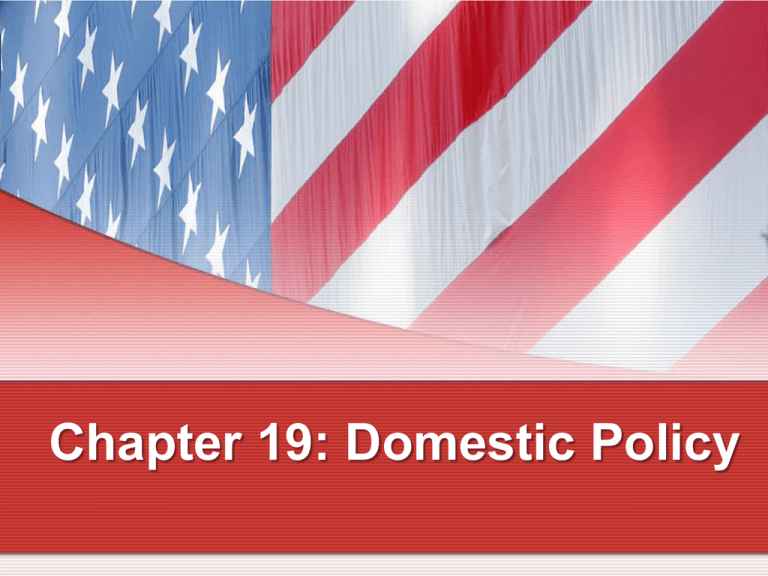
Chapter 19: Domestic Policy What is Domestic Policy? • All government laws, planning and actions involving internal issues of national importance, including: • • • • • • Health care Poverty Crime Environment Education Immigration 2 The Policy-Making Process • • • • • Agenda Building Policy Formulation Policy Adoption Policy Implementation Policy Evaluation 3 Evolution of Social Welfare Policies • Most of our major federal social welfare programs were developed in the 1930s as part of the New Deal’s response to the Great Depression. A homeless Oklahoma family during the Great Depression. Library of Congress 4 Direct Federal Aid More than 80 million Americans receive direct federal aid. 5 Health Care • Rising Cost of Health Care • Advanced technology costly • Government provides 1 in 3 Americans with health care coverage • Millions still uninsured • Medicare • Federal health insurance for elderly and disabled • Medicaid • Health insurance for low-income families 6 Health Care (cont) • The Uninsured • The uninsured employed • Shifting costs to the uninsured • Will new legislation bring relief? • National Health Insurance • The Canadian system • Health savings account (AP Photo/Rogelio Solis) 7 Health Care Reform Almost 100 million Americans receive some coverage from government-provided health insurance. 8 The Drive to Expand the Role of Government in Domestic Affairs Controversial health care reform package passes in the U.S. Senate, but legislation is not final. Air Date: 12/24/2009 Click the icon to open the movie Video Supplied by Motion Gallery 9 Video Questions 1. Why do the House and Senate versions of the health care reform bill differ? 2. Why is this legislation so controversial? 3. Which groups are most likely to support this version of health care reform? Least likely? 4. In what other areas has the role of the federal government recently expanded? 10 Click on images Percentage of Total Net Income Spent on Health Care in the U.S. 13 Cost of Health Care in Economically Advanced Nations 15 Poverty and Welfare • Income transfers • Transfers of income from some individuals in the economy to other individuals • Generally done by way of the government • Those believing private property is preeminent right tend to oppose income equalization programs • Low-income population • 10% of all Americans • Larger percentage of Latino and African Americans • More prevalent among female-led households 16 Figure 19.2 The Feminization of Poverty 17 Poverty and Welfare (cont) • Basic Welfare • Aid to Families with Dependent Children (AFDC) • Temporary Assistance to Needy Families (TANF) • • • • • Welfare Controversies Supplemental Security Income (SSI) Earned Income Tax Credit (EITC) Farm Subsidies Homelessness 18 The Official Number of Poor in the United States 19 Click on image for Poor in America 2010 Figure 19.4 Poverty in the States 22 Figure 19.3 Families on Welfare, 1955-2008 23 Life Expectancy in the U.S. 25 Social Security and its Problems • Aging of population • Ratio of active workers to retirees is declining • Presidents and Congress continue to use Social Security trust fund surpluses to offset deficits • Expectation that revenues will fall below program costs as early as 2017 • In 2009, Social Security taxes produced more than 35% of federal revenues 26 Social Security Solutions? • Privatization of Social Security • Reducing benefits • Small changes • Periodic increases in the share of earnings subject to tax • Reducing cost of living increases • Raising the retirement age 27 Immigration • Continued immigration influx • More than a million people a year immigrate to this country. • Minority groups will constitute the “majority” of the U.S. by 2060 • Positives of immigration • Offsets low birthrate, aging population • Provides workers in jobs Americans do not want 28 Attempts at Immigration Reform • 2006 Congress initiated, but did not pass, sweeping legislation that would make all illegal immigrants in the United States felons • Immigration rallies continue • Controversial laws challenged in various states 29 Criminal Policy • Crime in American History • Crime control model: controlling crime • Due process model: attaining justice • Continuous tug-of-war between two models • Congress taking larger role in criminal justice policy • New issues: racial profiling, rendition, drugs, terrorism 30 Declining Crime Rates 31 Declining Crime Rates (cont) Declining Homicide Rates Declining Theft Rates 32 Incarceration Rates The United States has the highest incarceration rate among major world nations measured by the number of prisoners per 100,000 residents. 33 Incarceration Rates by Population Group Incarceration rates Per 100,000 Persons 34 Criminal Policy (cont) • Federal Drug Policy • Money spent on federal drug interdiction programs has not met with much success, as illegal drug consumption in the U.S. has remained steady. • State and local governments have been attempting new remedies to curtail the drug problem. • Confronting Terrorism • Counter-terrorism strategies will necessarily be a part of federal government policy for years to come 35 Environmental Policy • Environmentalism • Conservation • Preservation • Environmentalist movement • Ecology 36 Cleaning Up the Air and Water • The National Environmental Policy Act • Curbing Air Pollution • The 1990 amendments to the Clean Air Act of 1963 constitute a comprehensive policy mandating cleaner air in urban areas. • Water Pollution • The Clean Water Act sought to make waters safe for swimming, protect fish and wildlife, and eliminate the discharge of pollutants into the water. 37 Cost-Effective Solutions • Clean Air Act of 1990 • As a result of legislation, air and water pollution is down dramatically from what it was three or so decades ago. Lead content in the air is 3 percent of what it was. Sulfur dioxide is down by four-fifths. (AP Photo/Nick Ut) 38 Cleaning Up the BP Mess The Gulf Oil spill becomes a political issue for the Obama administration. Air Date: 2010 Click the icon to open the movie Video Supplied by Motion Gallery 39 Video Questions 1. How does the Natural Resources Defense Council hope to use the oil spill impact to further its mission? 2. Is President Obama’s political legacy at stake over this issue? Does this event affect domestic energy and environmental policy? 3. What has changed during the lengthy cleanup process? Has the blame shifted from BP to the federal government? Why or why not? Copyright 2011 Cengage Learning 40 Other Environmental Issues • The Endangered Species Act (ESA) • Global Warming • The Kyoto Protocol • The Global Warming Debate 41 Tragedy of the Commons • Increasing domestic regulation prompted by growing concerns over common resources • Greater awareness, costs to community • More government regulations • Costs to business 42 Questions for Critical Thinking 1. Will recent legislation help protect the uninsured population from catastrophic medical costs? 2. Should Social Security be expanded or reduced in scope? Who is most likely to benefit from privatization? 3. Should illegal immigrants be included in government assistance measures? 43 Questions for Critical Thinking 4. Prison populations continue to explode. What can be done? 5. Why are environmental problems often difficult to legislate away? What are the most pressing issues in air and water quality? 6. How should this country formulate environmental policy? Who should benefit most? The least? 44 Web Links • • • • American Public Human Services Association National Conference of State Legislators Social Security Online U.S. Department of Health and Human Services 45

